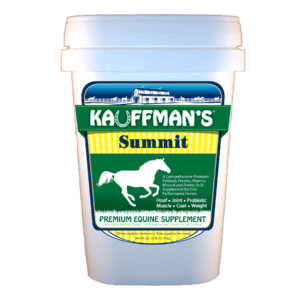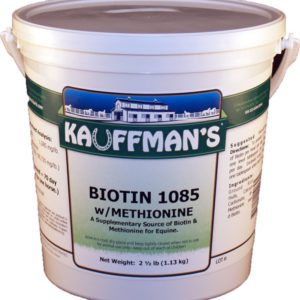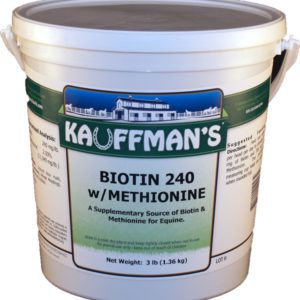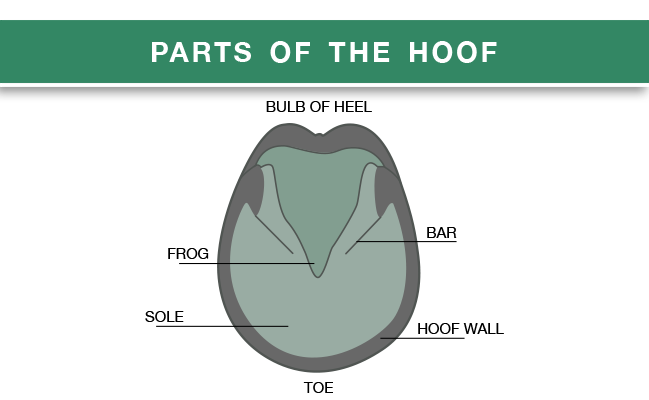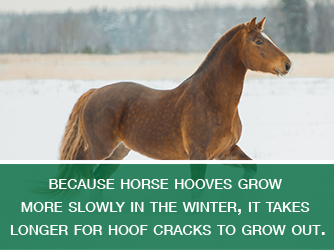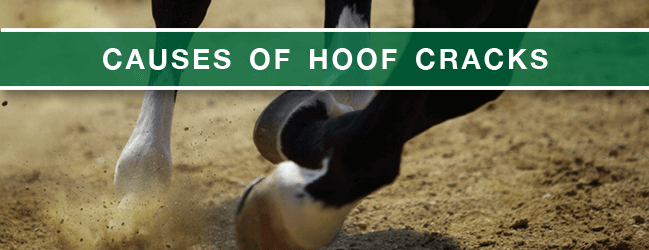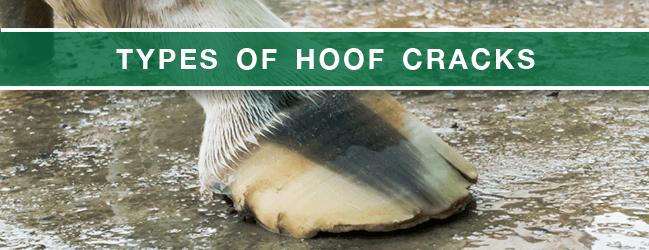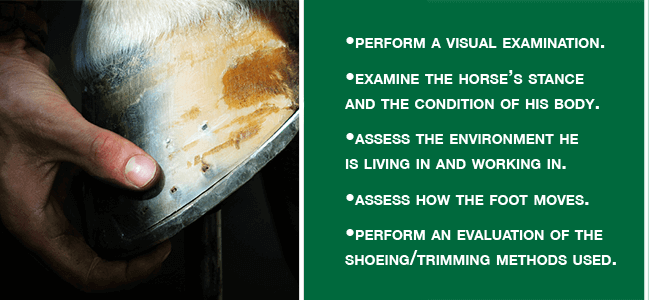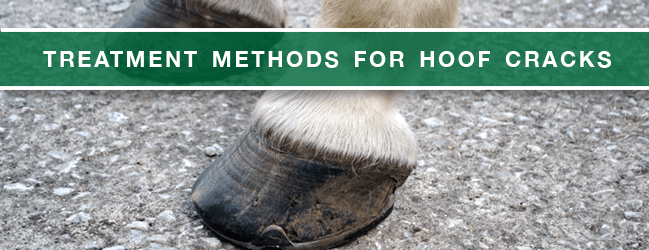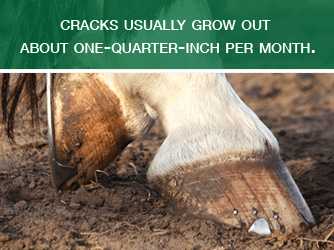Hoof Cracks: The Most Effective Forms of Treatment
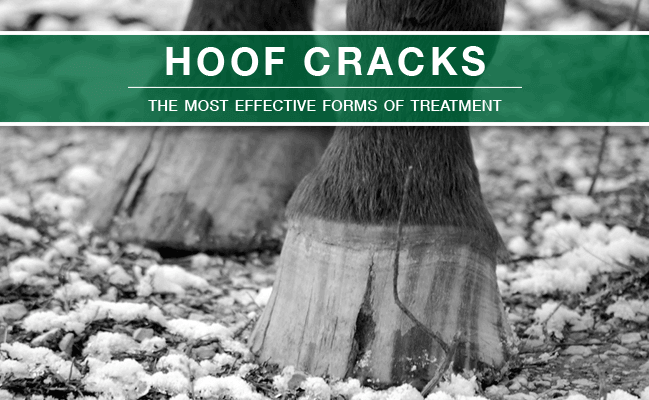
Quick Links: What is Hoof Crack? | Causes | Types | Treatment | Hoof Care Tips | Helpful Products
Get Horse Hoof Supplements Today!
-
 KAUFFMAN’S® Summit$83.05 – $571.00
KAUFFMAN’S® Summit$83.05 – $571.00 -
 Biotin 100$22.25 – $96.55
Biotin 100$22.25 – $96.55 -
 Biotin 1085 with Methionine$45.80 – $352.25
Biotin 1085 with Methionine$45.80 – $352.25 -
 KAUFFMAN’S® Integri-Hoof$41.15 – $283.10
KAUFFMAN’S® Integri-Hoof$41.15 – $283.10 -
 Biotin 240 with Methionine$25.10 – $65.60
Biotin 240 with Methionine$25.10 – $65.60
To perform his best, healthy hooves are vital to your horse. While you do whatever you can to ensure your horse’s hooves are healthy, issues aren’t completely avoidable. No matter how well you take care of your horse’s hooves, there is still a chance that cracks can develop.
While many cracked hooves on horses are superficial or cosmetic and don’t cause extensive damage, in some horses, hoof cracks can be a persistent and a serious problem. For example, 90% of quarter cracks in performance horses are related to hoof balance, while 10% are a result of an injury from a pathological incident that compromised the hoof wall.
No matter what happened to cause them, hoof cracks can come on out of nowhere, and they can be quite troubling to treat. Read this guide to learn more about what causes hoof cracks, their impact on the horse and how to treat cracked hooves.
What Is a Hoof Crack?
To understand what a hoof crack is, you first have to understand the anatomy of a horse’s hoof. The outer portion of a horse’s hoof is very similar to a human’s fingernails or toenails. Like a human’s nails, the outer portion of a horse’s hoof grows from the coronary band, downward.
That hard, outer portion of a horse’s hoof starts out as epidermis cells — the same cells that create the outer portion of the skin. There aren’t any blood vessels in these cells, they get oxygen and other nutrition from the exchange of fluid that occurs with the dermis that lies underneath.
The epidermis cells that are located closest to the surfaces of the hoof get overloaded with proteins, which cause the cells to die. This can create drying and hardening of the hoof wall. Just like your fingernails, you can maintain the overgrown outer portion of a horse’s hooves by cutting and filing them without causing any pain, as long as the living tissue that is located beneath is not disturbed.
Horses That Are Affected by Hoof Cracks
Hoof cracks are common, and they aren’t specific to one breed or sport type. However, horses that race or perform a heavy workload are more likely to suffer from hoof cracks than those who do not participate in strenuous activities.
Experts suggest this is related to the fact that race and heavily-worked horses are frequently shod, and they walk on hard surfaces. It seems that racehorses suffer the highest incidence of hoof cracks out of all horses, which is likely because of how often they need shoes and because of the rough surface of the tracks their hooves are subjected to.
Likewise, during the winter months, the incidence of hoof cracks tends to be higher than in the warmer months. Because horse hooves grow more slowly in the winter, it takes longer for hoof cracks to grow out.
With that said, while there is an increased chance your horse will experience cracks — or more frequent cracks — in the hooves if he races, performs heavy workloads or spends a lot of time outside in the winter, all horses will likely experience hoof cracking at some point.
Causes of Hoof Cracks
To understand how to properly solve horse hoof problems like hoof cracks, you should know why the crack formed in the first place.
Your horse may be experiencing hoof cracks because of many factors, including:
- Poor foot conformation (club foot, a long toe and low heel, sheared heels and thin hoof walls) – This is the most common cause for hoof cracks. When your horse has poor foot conformation, they move their leg forward abnormally and the hoof eventually migrates inwards. In such a case, your horse will develop a cracked hoof even due to a prolonged trot since they don’t have a level footfall.
- Trauma to the coronary band – The coronary band is where the hoof gets its hard and elastic composition. If the coronary band is damaged in any way, the developing hoof won’t be as strong. Weak hooves generally crack easily and they may not be as easy to fix.
- Pre-existing damage to the laminar corium, caused by infection – The laminar corium is the inner hoof tissue that contains blood vessels. This is a very sensitive area on your horse’s hoof. Any severe damages could cause your horse to become completely lame or lead to a hoof crack depending on the intensity of the damage.
- Short shoes – The horseshoe has a direct impact on your horse’s gait and stance, but it also affects the growth of the hoof wall. If the shoe isn’t a perfect fit, it will deform the hoof, impede foot balance and eventually result in cracks. When the shoe is short, the heel won’t be supported and your horse will have to shift the balance to the front of the hoof. The extra pressure is what will weaken and eventually crack the hoof.
- Focal foot imbalances – This is when your horse shifts his weight to a specific part of the hoof instead of balancing it out as intended. Horses do that for a variety of reasons including pain or discomfort in some part of the foot. The area where your horse places most of his weight will eventually crack along its vertical axis.
- Heavy workloads
- Exposure to abrasive services – Abrasive surfaces tend to crack your horse’s hooves due to the excess pressure required to navigate.
- Extremes in environmental conditions – When the hoof is waterlogged, the horn grows soft and crumbly. As a result, it becomes easy to crack even under the slightest pressure. Then, when it dries up, it becomes brittle and just as easy to crack.
- Poor diet – The hoof wall is similar to human nails in more ways than one. This is why hooves can be affected by your horse’s diet. If your horse’s hooves are brittle and crack too frequently, you may want to change his diet and include more biotin, selenium, Vitamin C, and Zinc among other vitamins and minerals.
- Lack of exercise – Your horse must get enough exercise every day. This is the only way to harden the hoof and strengthen your horse’s muscles. Without exercise, your horse’s hooves will be delicate and easy to crack, even during minimal exertion.
Types of Hoof Cracks
Your horse may experience a wide variety in the types of hoof cracks he can develop. These cracks can range from mild to moderate to severe. Some of the most common hoof cracks include:
- Grass cracks – Generally, these cracks are superficial. They start from the ground and move upward in the hoof. They are typically very thin and don’t penetrate into the wall of the hoof. Grass cracks are usually caused by changes in the condition of the ground the horse walks or stands on, poor nutrition and a lack of exercise.
- Sand cracks –These cracks are similar to grass cracks, but the difference is that they start from the coronary band and move downward, whereas, in the grass crack, the crack starts at the ground and moves upward.
- Heel cracks – These cracks tend to be painful for the horse. They are often the result of short shoeing, in which the heel of the horse’s shoe does not cover the heel of the horse’s foot. This type of crack can also be the result of a shoe that is too long. When a shoe is too long, it creates leverage, which applies excessive force to the heel, thus causing a crack to form.
- Bar cracks –These cracks appear in bars, or the inward folds of the hoof wall that are situated on either side of the frog. These cracks can also be painful, and they are often caused by trauma to the foot.
- Toe cracks – When a horse overloads or puts excessive weight on the toe (puts too much weight on it when he walks), cracks in the toe can form.
- Quarter cracks – These cracks can be the most difficult to manage. A heel crack is typically caused by the uneven landing of the foot while walking. This happens when there are conformational defects, including a carpus valgus (the outward deviation of the lower limb, starting from the knee) or varus (an outward deviation of the lower limb that starts from the knee and presents itself as toeing in). A quarter crack can also be the result of a variety of other factors, like neglect, imbalance, coffin bone defects, fractures, keratomas or the constant impact on hard surfaces.
Examining the Horse’s Hoof
To determine whether or not your horse is suffering from hoof cracks and what type of hoof cracks he may be suffering from, you need to perform a thorough examination of his feet and look for the following:
- Analyze the foot yourself. Perform a visual examination, use hoof testers and so forth.
- Examine the entire horse to determine his stance and the condition of his body.
- Assess the environment he is living in and working in.
- Assess how the foot moves.
- Perform an evaluation of the shoeing and/or trimming methods that are used.
Before performing any evaluation, you should first make sure your horse’s foot is thoroughly cleaned. Use a wire brush to remove as much dirt and debris as possible. Cleaning the hoof prior to the examination will allow you to get a good look at the condition the hoof and foot are in.
Hoof Cracks and Equine-Related Sports
Hoof cracks can range from minor to severe. However, for those horses that perform in equine-related sports, such as racing or polo, hoof cracks can be seriously problematic.
For example, even if a crack is minimal, for a horse exposed to the abrasive surface of a race track and with excessive pressure on his feet for long periods of time, that minor crack can quickly turn into something more severe. When a hoof crack becomes severe, it can not only be painful and impact a horse’s performance, but it can lead to an infection that could potentially be deadly.
With that in mind, no matter how minor a hoof crack may appear, it is important to provide the proper care and treatment for the crack. The horse should not participate in sport-related activities until the issue is completely resolved.
Treatment Methods for Hoof Cracks
Several types of treatment options are available for repairing hoof cracks. Before deciding on the best repair method, you’ll need to determine the type of hoof crack the horse is suffering from, its location and how extensive the hoof crack is. All of these factors must be figured into the appropriate repair method, though there are other components that will also be taken into consideration when determining what to use on cracks in horses’ hooves, including:
- The cost of the repair and treatment
- The location of the crack
- The time it will take to treat the crack
- The horse’s daily function
Whatever repair and treatment method you choose to treat the hoof crack, it is vital to ensure the farrier has experience with that particular method.
There is not one specific technique that will solve the problem for every horse. Each horse is different, and the environment, the amount of work the horse performs and the type of hoof crack the horse is suffering from are all things that need to be considered when you choose the method of treatment and repair.
The following are some of the techniques that are currently being used the most:
- Removal of the hoof wall to make the hoof non-weight bearing below the crack.
- Removal of the crack by removing the offending wall.
- Rasp or bum across the top of the crack.
- Stabilize the crack by nailing across the crack, by using clamps, by applying sutures across the cracks, by patching the defect or by placing screws or wires across the crack.
- Applying shoes or tapes to the cracked hoof.
It is important to note that if your horse’s hoof crack has been bleeding, is infected or is filled with fungi or other bacteria, it should not be covered with any type of material until it is completed drained and medicated. Covering an infected crack will only make the problem more severe, causing the growth of bacteria and infection to continue. Eventually, the hoof will require surgery to repair.
Whatever type of treatment your farrier determines is the most effective for your horse, you should know that the main goal is to stabilize the cracked hoof. The treatment should also protect the damaged wall and reduce the amount of pain and bleeding the horse is experiencing, as well as inhibit the further development of infection.
While all methods used to repair a hoof crack involves expense and takes time, one of the easiest and least expensive repair techniques is to fit the horse with a bar shoe, either with or without clips, to anchor the shoe to the wall of the hoof, thus providing more stability.
No matter what technique is used, though, you should always reduce the amount of work your horse performs during recovery and ensure he is rested. This will provide him with the proper time needed for the crack to grow out, which is usually about one-quarter-inch per month.
Horse Hoof Care Tips
While it may not be possible to completely avoid the development of hoof cracks, there are things you can do to help with their prevention — especially if you’re caring for horses with weak or brittle hooves. The best thing you can do to prevent a hoof crack is to have an experienced farrier manage the care of your horse’s feet. Care should be done on a continuous basis. Your horse should also receive proper exercise, eat a nutritious diet and receive high-quality supplements to ensure health.
Key Takeaways for Hoof Cracks
While the majority of hoof cracks tend to be minor, they all need to be treated correctly to ensure proper and timely healing. Regularly inspect the condition of your horse’s feet to determine whether or not a crack is developing. The hooves should be cleaned and re-shoed in the appropriate manner. Providing your horse with the proper diet and exercise is also important to help prevent the development of hoof cracks, as is providing him with the right supplements and hoof conditioners.
If your horse does develop a hoof crack, make sure you seek the treatment of an experienced and knowledgeable farrier or veterinarian. Once the best form of treatment is determined, be diligent in providing your horse with the care he needs to properly recover. This includes reducing the workload and providing your horse with opportunities for rest. You should also make sure the surfaces the horse walks on are not further aggravating the situation.
The biggest key to seeing that your horse’s hoof cracks heal properly is patience. The amount of time it takes for a crack to heal depends on the extent of the crack and the type of treatment your horse is receiving.
No matter what, it can take a long period of time for a horse to recover from a hoof crack. Trying to speed up the recovery, or making your horse perform heavy workloads before he is ready to will only aggravate the situation and make matters worse.
The health and wellness of your horse, and how well he performs, depends largely on the health of his feet. Making sure your horse receives the right treatment for hoof cracks is vital.
What to Use for Helping to Prevent Cracks in Horses’ Hooves
Ensure your horse has healthy hooves by providing superior nutritional support for his hooves — the very foundation of your horse! High-quality hoof supplements, such as Kauffman’s® Integri-Hoof, feature all the key nutrients, in proper amounts and ratios, required to support development and maintenance of strong, healthy hooves. Key ingredients include amino acids (methionine, glycine and lysine) combined with essential proteinated trace minerals (zinc, copper and cobalt) and B vitamins (including biotin).
To learn more about how to prevent and treat cracked hooves in horses as well as a variety of other equine care tips, visit Kaufmann’s, A Daniel Baum Company today.

